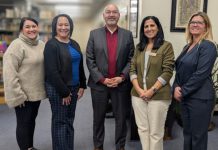More than 500 elementary students sang
”
What a Wonderful World
”
in unison Monday morning at El Roble School, marking the close
of their summer classes
– and for some – their music education. Music is not a
curriculum requirement for Gilroy Unified School District students
until they reach the fourth grade.
Gilroy – More than 500 elementary students sang “What a Wonderful World” in unison Monday morning at El Roble School, marking the close of their summer classes – and for some – their music education. Music is not a curriculum requirement for Gilroy Unified School District students until they reach the fourth grade.
During summer school, students attend music classes twice a week – double the amount fourth and fifth grade students receive during the regular school year.
“Every child needs to have music,” said Dr. Gretchen Vandenberg, who has taught music for the past 30 years in the district. “We’re just happy that it was available for summer school students.”
For 7–year–old Ami Partida, music class was the highlight of attending summer school.
“My favorite part was when we learned how to sing,” she said. “It’s a lot of work to play the drums.”
According to Vandenberg, the district began making cuts to the elementary music program in the early ’90s due to budgetary reasons.
The music program became available for summer school students after the Connell family of Gilroy donated money for the cause to the Gilroy Foundation seven years ago, she said.
“It seems to be budget controlled, but I think it’s priorities,” Vandenberg said. “Some of the most recent research is showing that when children participate in music (education) that it stimulates the part of the brain that serves memory.”
The theme of Monday’s concert was What a Wonderful World, and the production featured songs with an environmental twist.
Preschoolers wore antennas and marched around the stage – serving as tiny reminders of the role every individual plays in the world, while the older classes sang of the need for recycling.
However, students were not simply learning how to keep the beat of a drum, or the ecological benefits of reusing plastic.
“Children need to develop their bodies before their brains will work – and music and dance do that,” Vandenberg explained.
She said dancing helps refine motor skills young students may not have fully developed upon entering elementary school, and that learning an instrument actually improves memory.
Vandenberg is not alone in her reasoning.
Numerous studies indicate that there is a correlation between music education and increased academic performance.
For instance, a 2003 study performed by professors at the University of Illinois, Urbana–Champaign found that students who received separate instruction in the areas of rhythm, piano, and singing all tested higher on spatial, sequencing and arithmetic tasks.
“Music turns the brain into a mind,” Vandenberg said.
However, as state standards increase, teachers have less time to devote to enrichment activities such as music and the arts.
While teachers may elect to teach their students music, many lack the background and the time, Vandenberg said.
“It’s a real tragedy,” she said.
But aside from the academic benefit of music instruction, one must not forget the entertainment factor.
A group of elementary students sat on a classroom floor following the Monday’s production, squirming with enthusiasm from their music classes.
“It’s fun!” laughed 9–year–old Richard Silva, who is looking forward to the fall for one reason: “In fourth grade we’re going to play a lot of music.”
He has not had a music class since last summer when he attended summer school.
Most of the students who attended El Roble this summer did so for remediation work, and music is an enrichment they may not see until the following year.
“We get the ones who need it most,” Vandenberg explained. “When you teach a child a song – you feed their soul.”















